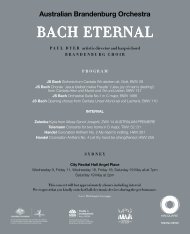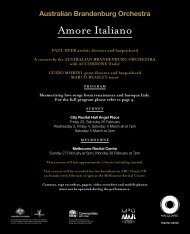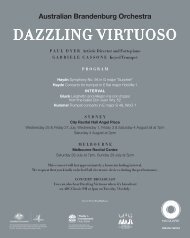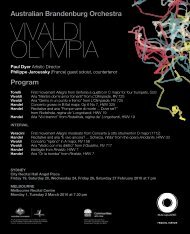download PDF program - Australian Brandenburg Orchestra
download PDF program - Australian Brandenburg Orchestra
download PDF program - Australian Brandenburg Orchestra
You also want an ePaper? Increase the reach of your titles
YUMPU automatically turns print PDFs into web optimized ePapers that Google loves.
THE CORNETTO<br />
THE SAXOPHONE<br />
The Cornetto, also variously known as Zink or Ye<br />
Sodding Stick, was arguably the most important<br />
soprano instrument in use from the fifteenth to late<br />
seventeenth centuries. The name 'Cornetto' literally<br />
means 'little horn' and the instrument evolved from<br />
early mouth-blown animal horns which over time<br />
had finger holes added to enable the performer to<br />
play a wider range of notes. The instrument exists in<br />
both straight and curved form, made of two pieces<br />
of wood hollowed out and bound together with<br />
leather. It has finger holes not unlike a recorder, and<br />
a tiny mouthpiece similar to brass instruments, into<br />
which the player buzzes their lips. Cornetti come in<br />
a variety of sizes, similar to many other families of<br />
instruments at this time, but they were most<br />
famously heard in combination with the sackbutt<br />
(early trombone). It was lauded as the instrument<br />
most able to imitate the human voice, the highest<br />
compliment paid to any instrument of the time, and<br />
it is very often heard with voices. One contemporary<br />
writer stated that the sound could easily be<br />
mistaken for a 'choice castrato'!<br />
It is a truly pan-European instrument, known to have<br />
been played in churches and royal courts as far<br />
apart as Spain, Poland, England, and everywhere in<br />
between. However, Italy is unquestionably its home<br />
particularly in Venice. There the best instruments<br />
were made, and arguably the greatest music was<br />
written for it. Composers such as Giovanni Gabrieli,<br />
composing his phenomenal polychoral works for<br />
buildings like San Marco and San Rocco in Venice,<br />
took advantage of the instrument's expressive<br />
capabilities. Many original Cornetti survive and it<br />
can be seen played by the angelic host in countless<br />
paintings, frescoes and carvings throughout Europe.<br />
I first came across the instrument as an undergraduate,<br />
sitting on a shelf in my teacher's studio. I picked it<br />
up, made one of the less flattering noises of my<br />
career, and swiftly decided that there was a very<br />
good reason these instruments had been hunted<br />
to extinction. It wasn't until some years later that<br />
I began to be seduced by the music of the sixteenth<br />
and seventeenth centuries. Eventually I bought an<br />
instrument, moved to England to study, and<br />
became a Cornettist.<br />
Perhaps my obsession with the Cornetto is due to<br />
the enigmatic and unique sound of this instrument,<br />
the challenge of playing it well, or the fact that we<br />
still have so much to discover about the instrument<br />
and its music. There is a freedom in the approach<br />
to cornetto playing and music of the sixteenth<br />
and seventeenth centuries. It revolves around<br />
virtuosic improvisation and ornamentation, and<br />
a very vocal way of approaching music; the perfect<br />
blend of showy extroversion and contemplative<br />
introversion. In short, the Cornetto represents<br />
one of the high points in Western music, and<br />
deserves much wider recognition by musicians<br />
and audiences alike. I hope you fall in love as I<br />
have with this unique sound, resurrected after<br />
some four centuries of obscurity.<br />
The Soprano and Baritone Saxophones I will<br />
be performing on this evening are both made by<br />
the Japanese instrument maker Yanagisawa.<br />
The technical capacity of these instruments is<br />
exceptional. They have a unique ability to allow a<br />
player to shape in the most personalised way, the<br />
quality and nuance of sound throughout the registers.<br />
This freedom for me playing on a modern instrument,<br />
means that within the Baroque context I am able to<br />
manipulate or "voice" the sound to suit this setting<br />
(rather like changing your accent if you like).<br />
Growing up in the small country town of<br />
Coonamble I was lucky enough to have parents<br />
who were passionate about music. Dad was very<br />
fond of the Saxophone (to his taste it was a better<br />
option than enduring morning practice sessions<br />
of the ‘indigestible’ Eb horn that I was assigned<br />
at school) and being at an age where everything<br />
Dad said was gospel, I dutifully began practicing<br />
the Alto Saxophone.<br />
It wasn’t until much later in my career that I<br />
discovered a penchant for Baroque music and<br />
began to investigate how I could play more of it<br />
and play it with a greater understanding of the<br />
style, ornamentation and performance practice.<br />
During this time I was listening to many different<br />
recordings and was struck by the fact that a lot<br />
of pieces written during this period were regularly<br />
played on a variety of different instruments. This<br />
fuelled me with new zeal to appropriate as much<br />
music as I could for use on the Soprano Saxophone<br />
- a practice with historical precedence! From about<br />
2002, I began researching original facsimiles both<br />
here and eventually in Europe to transcribe them<br />
and shape them to suit the tonal colour and<br />
technical idiosyncrasies of the Saxophone.<br />
Over the last 10 years I have refined my musical focus<br />
in this direction and have discovered in my pursuit of<br />
more “new” music for the Saxophone many amusing,<br />
bizarre, compelling and very human anecdotes about<br />
iconic composers of the Baroque period. In so doing, I<br />
have been completely drawn into their lives and this<br />
era and have discovered even more about the how<br />
and why of playing this stunning music.<br />
For me the purity and simplicity of the melodies in<br />
Baroque music, the joy and the beauty that you can<br />
find in one phrase, is second to none! Working with<br />
players who are drawing on this same energy and<br />
transcendental beauty is exhilarating, exceptionally<br />
satisfying, and never more so than when I am playing<br />
with the fantastic <strong>Brandenburg</strong> <strong>Orchestra</strong> and Choir.<br />
Christina Leonard<br />
www.christinaleonard.com.au<br />
Whilst never wanting to pursue a career as a Jazz<br />
Saxophonist the freedom of improvisation was always<br />
a fascination for me. It was wonderful to have this<br />
freedom reinstated into my playing through<br />
8<br />
Matthew Manchester<br />
www.camerataantica.com<br />
the beauty of Baroque ornamentation - another<br />
unexpected bonus on my musical journey!<br />
9
















